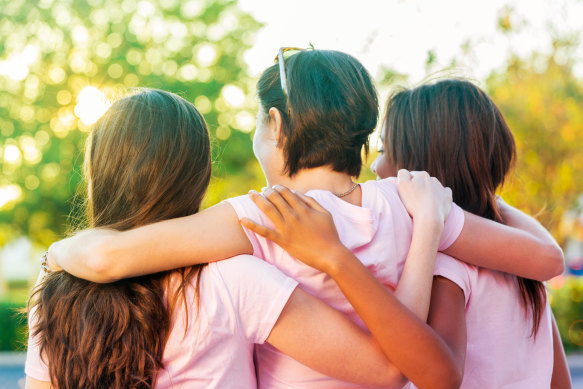This was published 8 months ago
Opinion
The Albanese government doesn’t just like women, it needs them
Jacqueline Maley
Columnist and senior journalistSince their time in opposition, Labor under Anthony Albanese has made “Appealing To Women” a point of pride, a direct riposte to the famous “Women Problems” of Scott Morrison’s government.
Appealing to women was a lofty goal, the moral imperative of a progressive party. A matter of economic prosperity as well as social equity. The incoming Albanese government vowed to treat women with respect, to spend money on unlocking their productivity, to make it easier for them to juggle work with mothering.
How refreshing. But also, how politically calculated: “Appealing To Women” is pure survival strategy. The Albanese government needs women as much as it likes them.

Jim Chalmers is the first treasurer to talk expansively about the gender pay gap and the economic productivity benefits of lifting women’s workforce participation.Credit:
Women are more likely to vote Labor than Liberal. The latest Resolve poll shows women are staying more loyal to Labor than men, who are deserting it in higher numbers.
At the same time, women voters – fickle creatures – are growing increasingly progressive, a trend observable across most Western democracies. In this Western democracy, it makes them appetising prey for the Greens and the teals.
So, Treasurer Jim Chalmers needed to throw the ladies some sugar in this, his third budget.
The measures are listed in the women’s budget statement – an initiative of the Morrison government, in a belated and rather reluctant response to that government’s aforementioned Women Problems.
It speaks volumes about our society that the first item listed is “gender-based violence”.
The biggest discrete women-directed policy is the $3.4 billion the government has set aside since October 2022 to address intimate partner violence (including $1.1 billion in this budget and the last mid-year economic and fiscal outlook).
This wraps in the recently announced $925 million put aside to make permanent the trial Leaving Violence Program.
There is also $4.3 million for the National Research Organisation for Women’s Safety and $3.9 million for the Department of Prime Minister and Cabinet to “embed a focus on women’s safety across government”.
The government has also directed $1 billion towards accommodation for women and children fleeing domestic violence.
Let’s dream big – one day those billions may be freed up for something more fun than just keeping us alive. (Tax rebates on foot rubs? A national ban on Book Week parade costumes? A Keanu Reeves-fronted education campaign on hot flushes? I’m spitballing here.)
But that day is some way off. The government’s plan to end gender-based violence stretches out to 2032, but none of us will hold our breath.
As the treasurer said in his budget speech: “We know there is more work for all of us to do.”
Quite.
For now, women must be grateful that the Commonwealth is trying to ward off their killing at the hands of intimates.
To his credit, Chalmers is the first treasurer to talk expansively about the gender pay gap and the economic productivity benefits of lifting women’s workforce participation.
The government has put some money where its mouth is – $1.1 billion for paying superannuation on government-funded paid parental leave.
One of Labor’s first acts in government was to boost the childcare subsidy – a major workforce participation measure – by about $5 billion.
By 2028, that subsidy will cost the Commonwealth $17 billion a year, and just like the National Disability Insurance Scheme, it is ripe for rorting.
The childcare subsidy reform announced in the budget will cut $410 million over the forward estimates by cracking down on compliance.
Or as the budget papers phrase it – “additional activities to strengthen the payment and accuracy of the child care subsidy program”.
The budget also sets aside $56 million for “women’s health”.
This includes $12.5 million over the forward estimates to provide period products to rural and remote First Nations communities and $6 million to pre-term and early-term birth in First Nations communities.
It is a sad indictment on Australian society that such measures are necessary.
There is also $7 million for miscarriage education and awareness material and bereavement services for women experiencing miscarriage and stillbirth, $5 million to train GPs to insert contraception devices, a teeny $1.2 million to train doctors to better treat menopause, and $1.1 million to develop an online “virtual contraception choice decision-making tree”.
Which sounds like a sort of pick-a-path game for ovaries.
Of course, the income tax cuts are the centrepiece of this budget, which must pull off the fiscal magic trick of providing cost-of-living relief while not worsening inflation.
Chalmers promises those tax cuts will help women the most. He says 90 per cent of female taxpayers will get a bigger tax cut than they would have from the previous Coalition government – an average benefit of $1650 (less than the male average because women earn less).
In terms of long-term fiscal trends, Australian women are having fewer babies, which has implications for tax revenues and immigration rates, and female workers in the care industries will be in greater demand as the population ages. Pity they’re not well paid.
The real money in the budget – more than $20 billion – goes towards the Future Made in Australia policy, which will invest in untested, male-dominated, green-tech manufacturing industries. A smidge over $55 million will be spent on helping women into these key industries.
Appealing to women has its fiscal limits.
Cut through the noise of federal politics with news, views and expert analysis. Subscribers can sign up to our weekly Inside Politics newsletter.